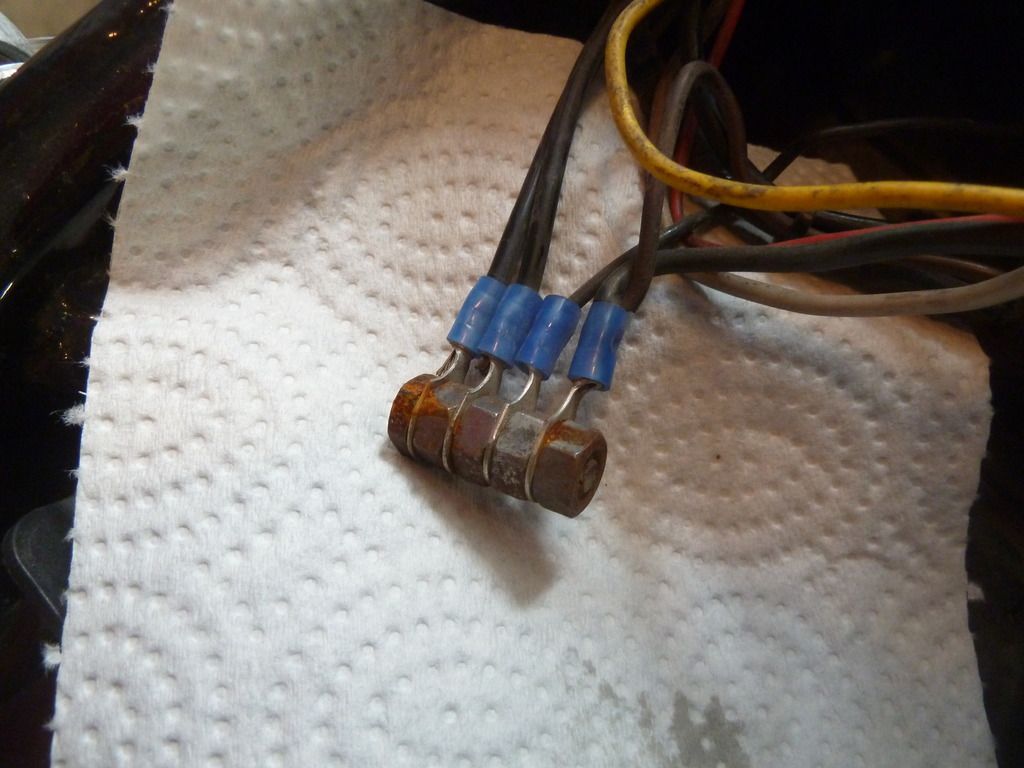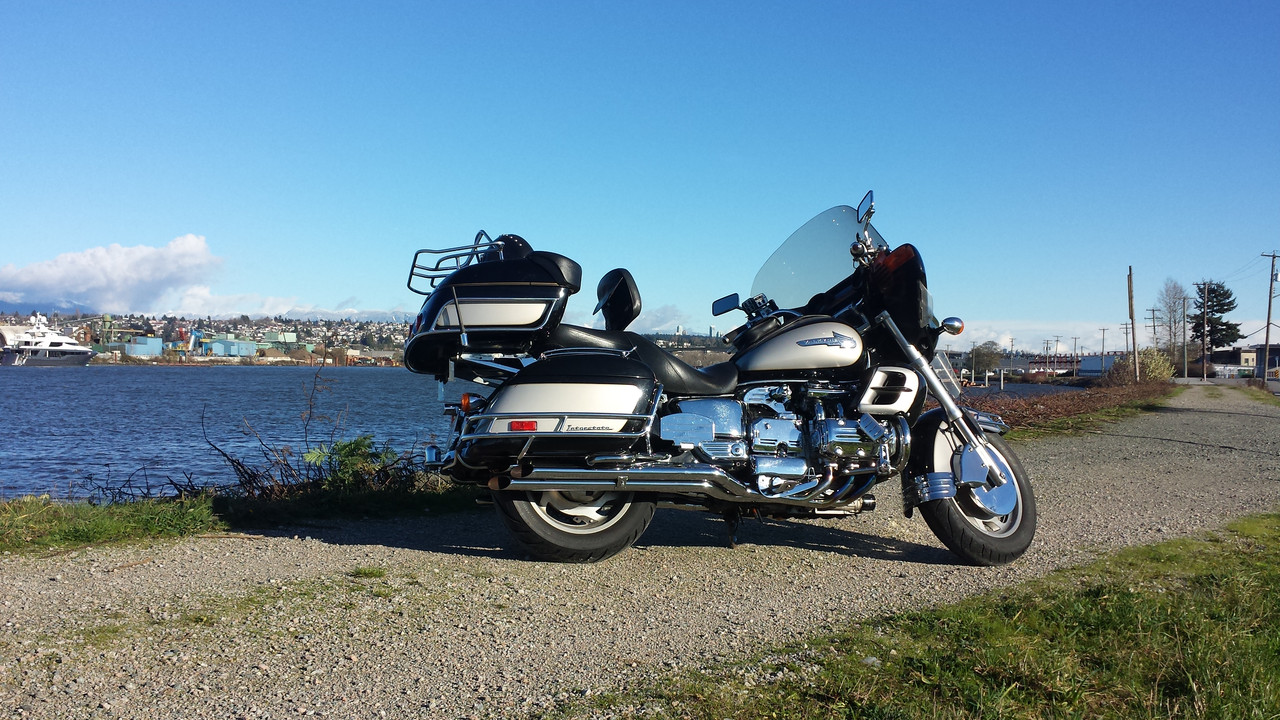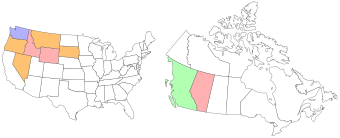|
Fiat Lux
|
 |
« on: September 07, 2015, 04:00:51 PM » |
|
Like many other Valkyrie enthusiasts, my black 2001 Standard was worked on by a previous owner who did some very cool things and some blindingly stupid things in his modifications. Wiring for ground effects lighting and truck-style air horns are among the more suspect mods that I am undoing or fixing. So here is a photo of what is undoubtedly the most creative electrical connection that I have ever seen.  By the way, this is on the back side of my battery box and while these are all grounds for two strand wire for ground effects lighting, there is another identical connection for hot wires not too far away. So to my questions: 1. Is this a standard agreed-upon method to connect wires in a motorcycle application? 2. It seems to work fine (three years without a hitch). What would you do with it? (Beyond rewrapping it and the positive wire connector not shown in electrical tape? Thanks for advice and please remember, this is not my work! Fiat Lux in Alberta |
|
|
|
|
 Logged
Logged
|
|
|
|
hubcapsc
Member
    
Posts: 16804
upstate
South Carolina
|
 |
« Reply #1 on: September 07, 2015, 04:08:24 PM » |
|
My PDM60 came with a "ground bus bar"... a studly wire lead
to the real ground and all the accessory grounds could be hooked
on the bus bar. Maybe yours is kind of a home made bus bar... does
one of those wires lead off to "the real ground"... ?
-Mike
|
|
|
|
|
 Logged
Logged
|
|
|
|
gordonv
Member
    
Posts: 5766
VRCC # 31419
Richmond BC
|
 |
« Reply #2 on: September 07, 2015, 04:58:31 PM » |
|
My only concern is the rust I see forming. I would go to stainless steel bolt/nuts instead. I also see no reason for one nut, one connector, and another nut. I've like 3 connectors on my one positive post on the battery.
|
|
|
|
|
 Logged
Logged
|
1999 Black with custom paint IS   |
|
|
|
Paladin528
|
 |
« Reply #3 on: September 07, 2015, 06:43:39 PM » |
|
This is fine for a ground but not for power. One short on a badly wired power line could torch your bike.
|
|
|
|
|
 Logged
Logged
|
|
|
|
Gryphon Rider
Member
    
Posts: 5232
2000 Tourer
Calgary, Alberta
|
 |
« Reply #4 on: September 07, 2015, 09:11:55 PM » |
|
I don't see a problem replacing that ground setup with stainless to get rid of the rust. Even the nuts in between are a good idea to keep all the terminals pointing the same direction, if that aids fitment. No need to wrap the ground terminals in electrical tape. For positive termination, an auxiliary fuse block makes the most sense.
|
|
|
|
|
 Logged
Logged
|
|
|
|
|
WintrSol
|
 |
« Reply #5 on: September 08, 2015, 07:52:59 AM » |
|
Steel of any kind is a poor conductor; brass or copper would be a much better choice. Personally, I would find an electronics shop and find an actual bus bar, which has threaded holes for attaching wires with ring terminals. You can get plain for grounds, and, if you're lucky, find one that comes mounted to a plastic insulator, for power. Or, you can just cut a slot in a thin strip of wood to make an insulator you can bolt down, so it doesn't move around and short.
|
|
|
|
|
 Logged
Logged
|
98 Honda Valkyrie GL1500CT Tourer
Photo of my FIL Jack, in honor of his WWII service
|
|
|
|
BobB
|
 |
« Reply #6 on: September 08, 2015, 10:09:57 AM » |
|
The steel nuts between each of those eyelet connectors make no sense to me. The connectors are made of a nonferrous metal, and should be just bolted together. All such connections on my Valk come back to the ground buss on the PC-8 or are soldered together...
|
|
|
|
|
 Logged
Logged
|
|
|
|
hubcapsc
Member
    
Posts: 16804
upstate
South Carolina
|
 |
« Reply #7 on: September 08, 2015, 10:35:47 AM » |
|
The steel nuts between each of those eyelet connectors make no sense to me. The connectors are made of a nonferrous metal, and should be just bolted together. All such connections on my Valk come back to the ground buss on the PC-8 or are soldered together...
Unlike most of the rest of y'all, I like the nuts, it keeps the circle connectors from being all glommed together... needs to be copper or something though... Those wire-ends (the circle connectors) are probably aluminum... -Mike |
|
|
|
|
 Logged
Logged
|
|
|
|
|
Paladin528
|
 |
« Reply #8 on: September 08, 2015, 01:21:44 PM » |
|
Either way eventually you are going to be grounding to steel so why not this way.
|
|
|
|
|
 Logged
Logged
|
|
|
|
Gryphon Rider
Member
    
Posts: 5232
2000 Tourer
Calgary, Alberta
|
 |
« Reply #9 on: September 08, 2015, 08:07:27 PM » |
|
Steel of any kind is a poor conductor; Test that theory with a jackknife and a house electrical receptacle. brass or copper would be a much better choice. Personally, I would find an electronics shop and find an actual bus bar, which has threaded holes for attaching wires with ring terminals. You can get plain for grounds, and, if you're lucky, find one that comes mounted to a plastic insulator, for power. Or, you can just cut a slot in a thin strip of wood to make an insulator you can bolt down, so it doesn't move around and short.
Wood on a motorcycle as an electrical insulator?  |
|
|
|
|
 Logged
Logged
|
|
|
|
|
Lyonardo
|
 |
« Reply #10 on: September 08, 2015, 08:08:52 PM » |
|
I like the design, and just might steal it. The battery post doesn't leave a lot of room for accessories.
Some type of rubber boot and maybe a little dielectric coating could take care of the rust.
|
|
|
|
|
 Logged
Logged
|
|
|
|
|
WintrSol
|
 |
« Reply #11 on: September 09, 2015, 07:54:52 AM » |
|
Steel of any kind is a poor conductor; Test that theory with a jackknife and a house electrical receptacle. brass or copper would be a much better choice. Personally, I would find an electronics shop and find an actual bus bar, which has threaded holes for attaching wires with ring terminals. You can get plain for grounds, and, if you're lucky, find one that comes mounted to a plastic insulator, for power. Or, you can just cut a slot in a thin strip of wood to make an insulator you can bolt down, so it doesn't move around and short.
Wood on a motorcycle as an electrical insulator?  Steel does conduct, but not as well as other metals; also, running current through ferrous metals causes corrosion more quickly than with other metals. That's why they stopped using the chassis as a ground distribution, when people demanded longer lasting vehicles, and now run ground wires through the harness. Wood sealed with an appropriate coating, like polyurethane, is an excellent insulator, and may be shaped to whatever space you have. Some woods don't even need sealing, because they are naturally resistant to water absorption; they also don't take paints well. They used to make cars and trucks with wood; our Model A Ford had wooden floorboards and roof, and it was 35 years old when my father bought it for my brother. |
|
|
|
|
 Logged
Logged
|
98 Honda Valkyrie GL1500CT Tourer
Photo of my FIL Jack, in honor of his WWII service
|
|
|
|
Paladin528
|
 |
« Reply #12 on: September 09, 2015, 08:54:46 AM » |
|
Actually running a current through the Chasis will prevent galvanic corrosion. There are actually components installed on some vehicles (also available aftermarket) that do just this in order to prevent corrosion.
Think of it this way. Corrosion is a battery discharging. Put a current to it and you will keep the battery charged so no corrosion.
On the Valk no matter what you do you will eventually have a ground wire to a terminal to a steel bolt to a steel frame. there is no other choice.
|
|
|
|
|
 Logged
Logged
|
|
|
|
|
WintrSol
|
 |
« Reply #13 on: September 09, 2015, 05:59:28 PM » |
|
Running a carefully controlled current will prevent galvanic corrosion; the random amounts of current through a typical electrical system is anything but, and all the joints the current has to cross will rust. The failing tail lamps on a '50s era auto were the among the first symptoms, as the body and frame began to rust. I have to periodically go through the lighting system on my '70 CB450 to make sure the lights stay on bright; now that most are LED, it's not as much an issue.
Yes, there is a connection to the frame from the ground terminal, but the frame is not used to conduct the current for most, if any, circuits. The frame is grounded so that it doesn't float relative to the engine and other systems, which would increase corrosion at the attachment points, due to random induced currents.
|
|
|
|
|
 Logged
Logged
|
98 Honda Valkyrie GL1500CT Tourer
Photo of my FIL Jack, in honor of his WWII service
|
|
|
|
Paladin528
|
 |
« Reply #14 on: September 10, 2015, 05:17:37 AM » |
|
Nearly all vehicles including the Valkyrie are Chassis ground. If they were not there would be an additional mile of wiring and way more connectors on the bike.
|
|
|
|
|
 Logged
Logged
|
|
|
|
|
WintrSol
|
 |
« Reply #15 on: September 10, 2015, 09:11:05 AM » |
|
Not according to the wiring diagram. There is a ground distribution wire (green) that is tied to the chassis, the diagram doesn't say where, but should be electrically close to the battery cable, which provides ground for nearly all circuits. There is a separate wire (green/black) that provides ground to the connector that connects the neutral, thermostatic, and oil pressure switches. Very little, if any, current is returned through the chassis itself. So, there is 'an additional mile of wiring and way more connectors on the bike'.
|
|
|
|
|
 Logged
Logged
|
98 Honda Valkyrie GL1500CT Tourer
Photo of my FIL Jack, in honor of his WWII service
|
|
|
|
Paladin528
|
 |
« Reply #16 on: September 10, 2015, 09:40:01 AM » |
|
The battery negative terminal grounds to the frame just in front of the battery below the alternator. There is no negative connection to anything else. By definition this is a chasis ground and all current eventually returns to the negative terminal of the battery. The Green is a negative return wire that eventually terminates in a chasis ground.
|
|
|
|
|
 Logged
Logged
|
|
|
|
|
WintrSol
|
 |
« Reply #17 on: September 10, 2015, 11:22:57 AM » |
|
I think that's what I said - without looking at where the green wire terminates on the chassis, I don't know how close it is to the battery cable, but it could be on the same bolt. The frame is not used for most ground distribution, only that part that may be between the green wire termination and the battery cable.
|
|
|
|
|
 Logged
Logged
|
98 Honda Valkyrie GL1500CT Tourer
Photo of my FIL Jack, in honor of his WWII service
|
|
|
|

